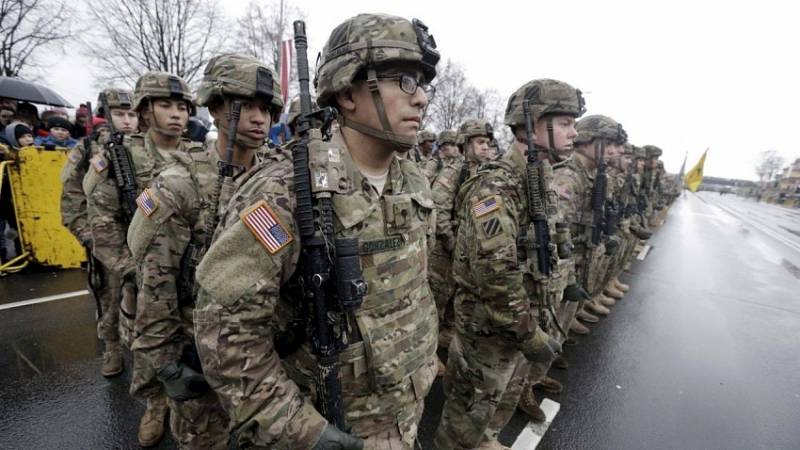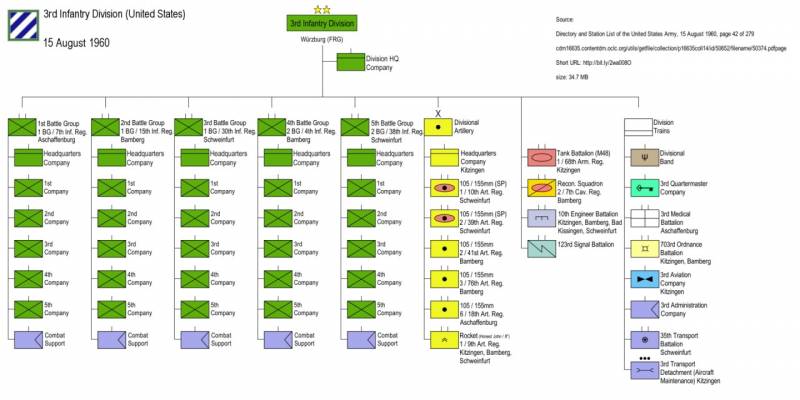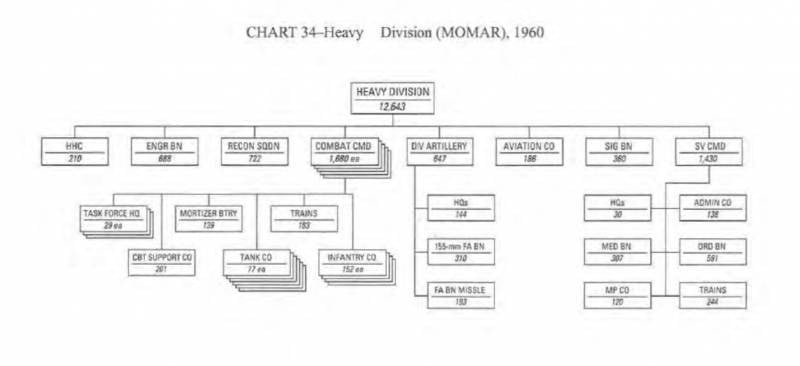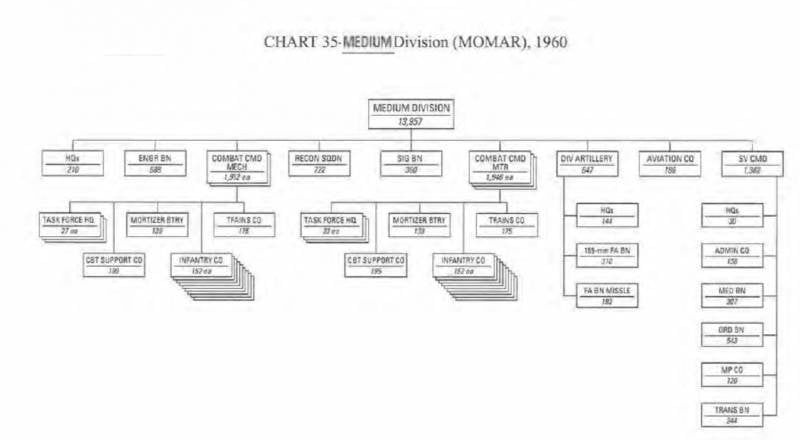Reorganization of the American divisions at the beginning of the 1960's. MOMAR-I and ROAD Plans
The series of these articles is based on materials published in the Foreign Military Review from 1972 to 1992. Used documents of the American Army series: FM-71-x, FM-71-100 (xx), FM-71-123 (xx), FM-8-10-5, FM-6-20-30, John Wilson's book " The evolution of divisions and individual brigades. "
Disclaimer Pentomic Division
President John F. Kennedy marked the beginning of an era of "flexible response" in 1961, deciding that the threat of a general nuclear war had diminished, but the likelihood of military action had increased. The army soon abandoned the "Pentomic Division" connections. “Pentomic Division” is a term intended to combine the concept of five subordinate units (“penta”) with the idea of a division that could function on an atomic or non-nuclear battlefield.
In fact, divisions were created with a standard division base and interchangeable divisions — infantry, mechanized infantry, airborne infantry, and armored battalions — divisions were combined to adapt and to serve in various conditions.
Theoretically, the idea led to the creation of more suitable forces and units that made full use of new weapons, in particular new Tanks, armored personnel carriers and helicopters.
Developing a MOMAR-I plan
To go beyond the unrealistic concept of the universal Pentomic Division, General Bruce Clark, commander of the Army Continental Command, directed the efforts of his staff to work on a new organizational model, the Modern Mobile Army of 1959 (MOMAR-I), in early 1965. Clark, who served as Deputy General Maxwell D. Taylor in Korea, believed that the army of the future should be able to act effectively on both the nuclear and non-nuclear battlefields anywhere in the world against various threats. His units were able to fight independently or semi-independently in a variety of geographical and climatic conditions. In addition, he is convinced that conventional firepower needs to be increased, and tactical mobility and maneuverability improved - primarily through the use of armored personnel carriers, aviation and helicopters.
After working through the plan, MOMAR-1 assumed a transition to heavy and medium divisions (1 and 2 diagrams). Both types had five combat teams (these are not brigades yet), but the teams had three headquarters of operational groups in which commanders could assign tank and infantry companies, support companies and a "moritzer" battery. The supposed "moritzer" was supposed to be something between a mortar and a howitzer. Thus, the new models retained the flexible command structure of the armored division and presented the idea of "building blocks" around which the forces of the new divisions were organized. Each person and each unit of equipment in both divisions had to be transported or installed on vehicles.
The symbols on the diagram require decoding:
HQ - headquarters and staff company
MP CO - Police Company
Combat cmd MECH - Mechanized Combat Command
Combat cmd MTR - Motorized (infantry on cars) combat command
Moritzer BTRY - Artillery battery of howitzers-mortars
Recon sqdn - reconnaissance squadron
Sig Bn - communications battalion
Task force HQ - joint operations department (headquarters)
CBT SUPPORT CO - combat support company
ENGR BN - Engineering Battalion
DIV ARTILLERI - Divisional artillery (not division)
155mm FA Cn - a battalion of field artillery caliber 155 mm (closer to the division in the SA)
FA Bn MISSLE - Field Artillery Missile Battalion
TRAINS CO (TRAINS) - transport support company
TRANS Bn (TRAINS / 244) - transport support battalion
Infantri CO - Infantry Company
TANK CO - Tank Company
MED BN - Medical Battalion
SV CMD - Support Command
AVIATION CO - Army Aviation Company
ORD BN (battalions) - repair and restoration battalion
The war games showed that the MOMAR-I medium and heavy divisions could not meet the needs of the army at many potential problem points around the world, and they never passed field tests. In December 1960, the Deputy Chief of Staff of the United States Army, General Clyde Eddleman, completely rejected this concept. He noted that MOMAR-I divisions lack the diversity, uniformity, versatility and flexibility that armies need to fulfill their “global responsibility” in the coming decade.
(If you compare the MOMAR-I plan with the existing Pentomic Division, you will find that the number of commands did not change and remained equal to 5, but each command had to have 10 mouth instead of 5. The total number of companies in the division increased from 25 to 50 , and also appeared additional SV CMD - command support.)
Go to ROAD plan
Further development was called Development of ROAD (Objective Reorganization of Army Divisions, 1961-1965).
General Eddlman directed the development of the divisional structure of the army to a new organizational course, 16 December 1960, when he commissioned General Herbert B. Powell, who replaced Clark as Commander of the Continental Command Army, for the period 1961-65. He wanted infantry, tank and mechanized divisions to be created. The heart of his mechanized division was to be armored infantry units with the mobility and survivability necessary for a nuclear battlefield. But all units had to have both nuclear and conventional weapon, as well as any other new weapons or equipment that could appear by 1965. Because of the many areas of "potential danger" around the world, Eddleman suggested adapting units for different conditions. However, since he still wanted the types of divisions to be as similar as possible, Eddleman instructed the developers to compare the creation of combat groups or their replacement by infantry battalions in both infantry and airborne divisions. He asked whether these divisions should have combat commanders or a regimental command level between the division commander and the battalions, as in an armored division. In addition, it was supposed to exchange divisional armored vehicles, mechanized infantry, infantry and artillery in the divisions. Eddleman expected that none of the division types would exceed 15 000 people.
Eddleman’s instructions reflected many of the organizational ideas that he had developed after leaving his post as deputy chief of staff for military operations in May 1958 and before returning to Washington as deputy chief of staff of the US Army in November 1960. Over the past period, he served as commander of the US Army in Europe and the Seventh Army, participating in the creation of the West German Army. This army, unlike some NATO countries that have adopted "pentagonal" divisions, used a structural approach to the organization. Instead of creating permanent infantry and armored divisions, the Germans relied on infantry and armored brigades, which would be formed in the division, designed for specific tasks. German brigades, although fixed organizations, could also contain additional battalions. To increase flexibility, units of armored and mechanized infantry battalions could be swapped to form combat teams, heavy infantry or armored ones.
Less than three months later, General Herbert B. Powell presented a study entitled “Objective Reorganization Army Divisions (1961 – 1965)”, usually called ROAD, for the Chief of Staff of the US Army, General George Decker. Unlike the PENTANA and MOMAR-I studies, ROAD did not consider a general reorganization of the army; it concerned only infantry, mechanized infantry and armored divisions. Using the armored division as a model, the study stipulated that all three types of divisions should have a common base on which commanders could assign different numbers of battalions — infantry, mechanized infantry, and tank battalions. The prevailing type of units determined whether the division was classified as an infantry, mechanized infantry or armored.
The base organization for each division of the ROAD was to consist of a headquarters that includes the division commander and two assistants to the division commander; three brigade headquarters; military police companies; battalions of army aviation, engineering and communications; reconnaissance squadron with aviation and three ground forces; divisional artillery; and command support. Three 105-mm battalions of howitzers (CA division), a missile battalion "Onest John" and a composite battalion (one 8-inch and three 155-mm howitzer batteries) were included in the division artillery. All artillery was self-propelled. However, the divisional artillery commander was transferred from a brigadier general to a colonel. The support command included a headquarters and a headquarters company, an administrative company, as well as a medical, supply and transport battalion. Despite the same structure in all divisions, the battalions of supply, transport and service differed in size and equipment to perform the tasks of the divisions. The commander of the support command assumed responsibility for all divisional supplies, maintenance and medical care, as well as for the activities in the rear, including security. Supply and maintenance functions were to be provided at a single point of service. The support command units were designed so that they can be detached and sent to support target groups in independent or semi-independent operations. The brigade headquarters, like the combat teams in the existing armored division, should not have permanently appointed units and should not be included in the administrative chain of command; instead, they were supposed to function solely as a command post control, controlling from two to five battalions in tactical operations.
The ending should ...




Information